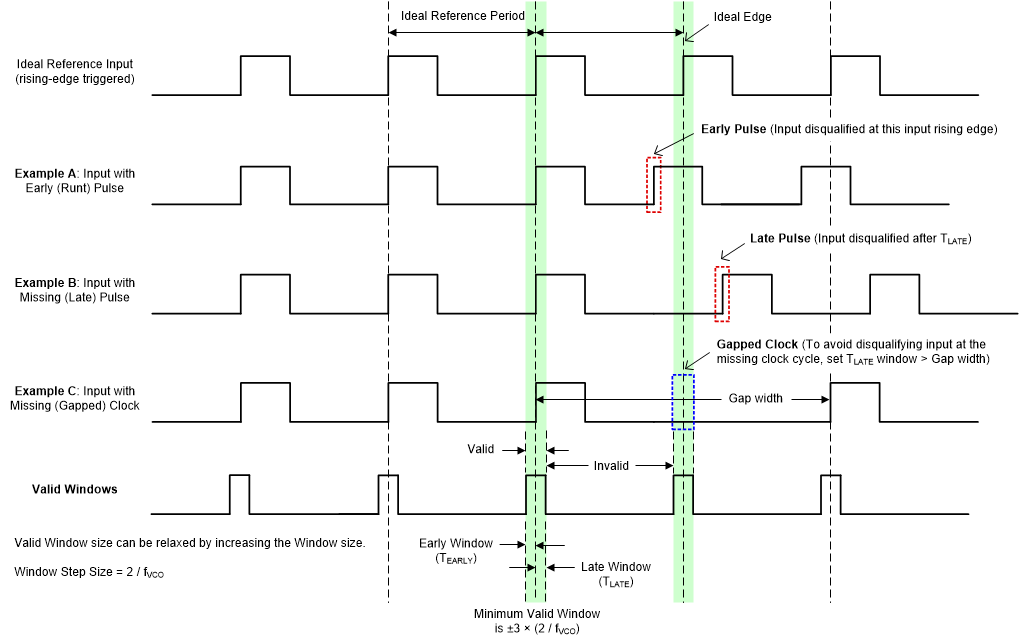SNAS884 December 2023 LMK5C33414AS1
PRODUCTION DATA
- 1
- 1 Features
- 2 Applications
- 3 Description
- 4 Pin Configuration and Functions
- 5 Specifications
- 6 Parameter Measurement Information
-
7 Detailed Description
- 7.1 Overview
- 7.2 Functional Block Diagram
- 7.3
Feature Description
- 7.3.1 Oscillator Input (XO)
- 7.3.2 Reference Inputs
- 7.3.3 Clock Input Interfacing and Termination
- 7.3.4 Reference Input Mux Selection
- 7.3.5 Hitless Switching
- 7.3.6 Gapped Clock Support on Reference Inputs
- 7.3.7 Input Clock and PLL Monitoring, Status, and Interrupts
- 7.3.8
PLL Relationships
- 7.3.8.1 PLL Frequency Relationships
- 7.3.8.2 Analog PLLs (APLL1, APLL2, APLL3)
- 7.3.8.3 APLL Reference Paths
- 7.3.8.4 APLL Phase Frequency Detector (PFD) and Charge Pump
- 7.3.8.5 APLL Feedback Divider Paths
- 7.3.8.6 APLL Loop Filters (LF1, LF2, LF3)
- 7.3.8.7 APLL Voltage-Controlled Oscillators (VCO1, VCO2, VCO3)
- 7.3.8.8 APLL VCO Clock Distribution Paths
- 7.3.8.9 DPLL Reference (R) Divider Paths
- 7.3.8.10 DPLL Time-to-Digital Converter (TDC)
- 7.3.8.11 DPLL Loop Filter (DLF)
- 7.3.8.12 DPLL Feedback (FB) Divider Path
- 7.3.9 Output Clock Distribution
- 7.3.10 Output Channel Muxes
- 7.3.11 Output Dividers (OD)
- 7.3.12 SYSREF/1-PPS
- 7.3.13 Output Delay
- 7.3.14 Clock Outputs (OUTx_P/N)
- 7.3.15 Glitchless Output Clock Start-Up
- 7.3.16 Clock Output Interfacing and Termination
- 7.3.17 Output Synchronization (SYNC)
- 7.3.18 Zero-Delay Mode (ZDM)
- 7.3.19 Time Elapsed Counter (TEC)
- 7.4 Device Functional Modes
- 7.5 Programming
-
8 Application and Implementation
- 8.1 Application Information
- 8.2 Typical Application
- 8.3 Best Design Practices
- 8.4 Power Supply Recommendations
- 8.5 Layout
- 9 Device and Documentation Support
- 10Revision History
- 11Mechanical, Packaging, and Orderable Information
Package Options
Mechanical Data (Package|Pins)
- RGC|64
Thermal pad, mechanical data (Package|Pins)
- RGC|64
Orderable Information
7.3.7.2.4 Runt Pulse Monitor (Early Detect)
The runt pulse monitor uses a window detector to validate input clock pulses that arrive within the nominal clock period minus a programmable early window threshold (TEARLY). When an input pulse arrives after TEARLY, the pulse is considered valid and the runt pulse flag will be cleared. When an early or runt input pulse arrives before TEARLY, the monitor will set the flag immediately to disqualify the input.
Typically, TEARLY should be set lower than the input's shortest clock period (including cycle-to-cycle jitter). The early pulse monitor can act as a coarse frequency detector with faster detection than the ppm frequency detector. The early pulse monitor is supported for input frequencies between 2 kHz and fVCO/12 and should be disabled when outside of this range.
Users must enable missing clock detect in order to use early clock detect. Early clock detect cannot be enabled alone.
 Figure 7-16 Early and Late Window Detector Examples
Figure 7-16 Early and Late Window Detector Examples